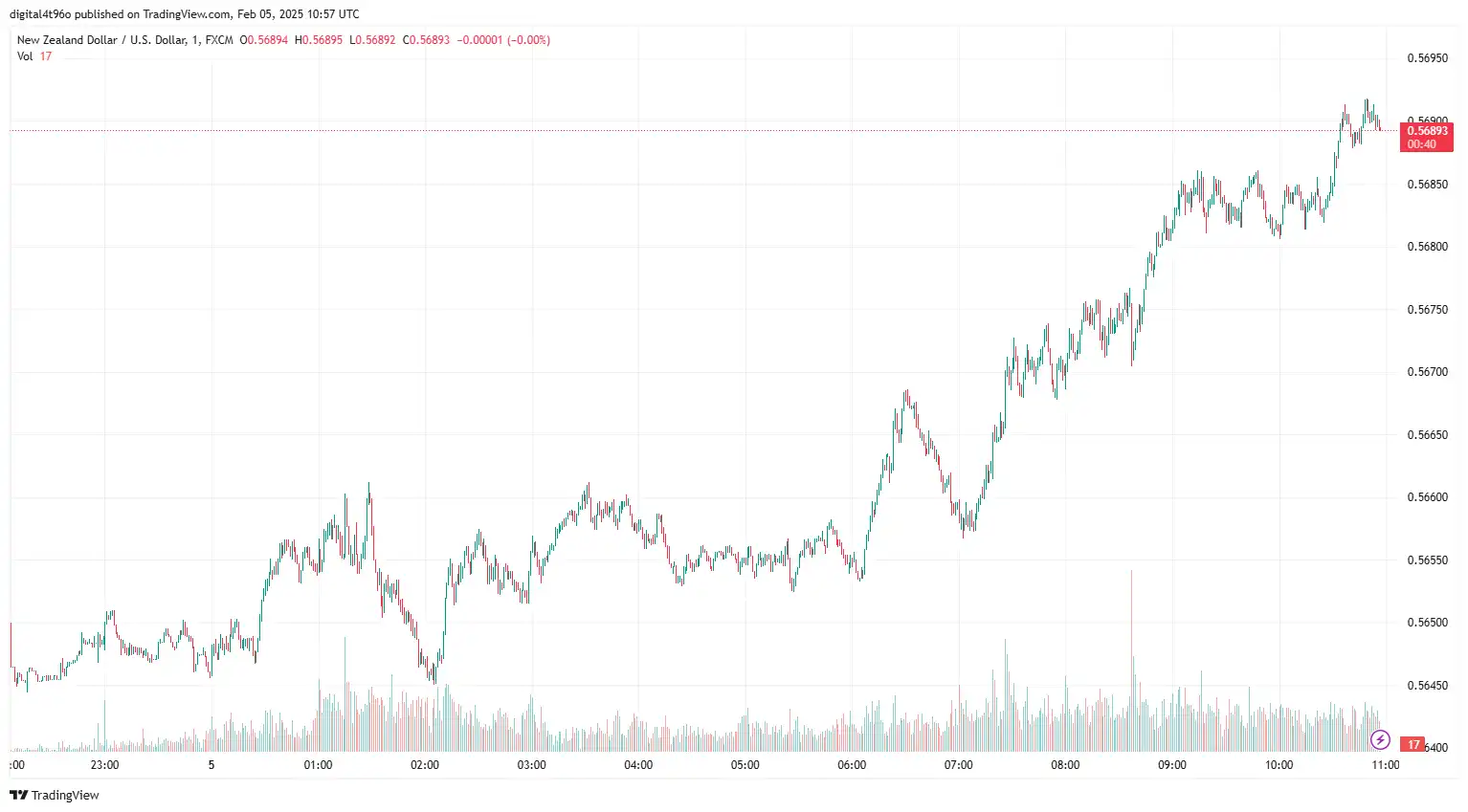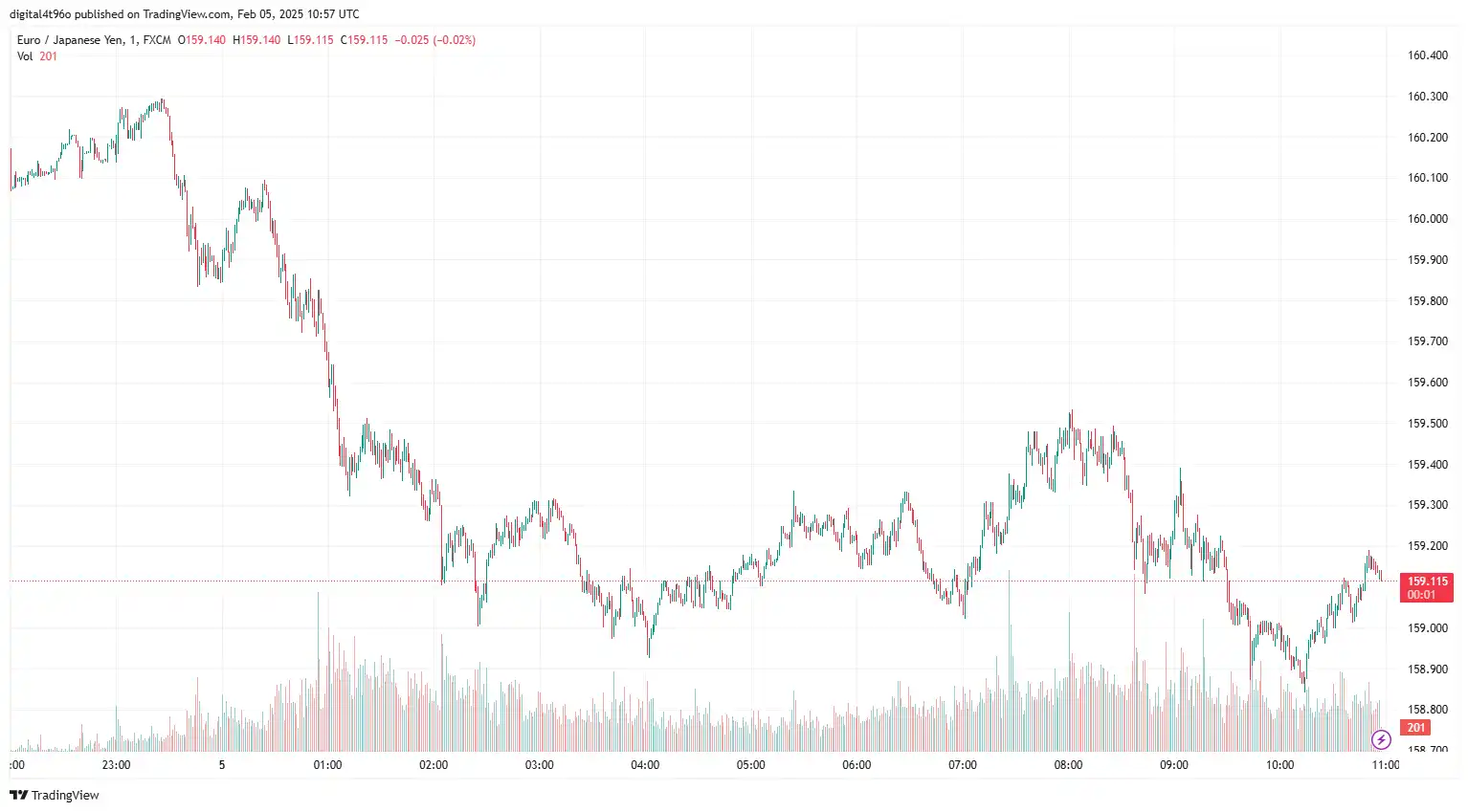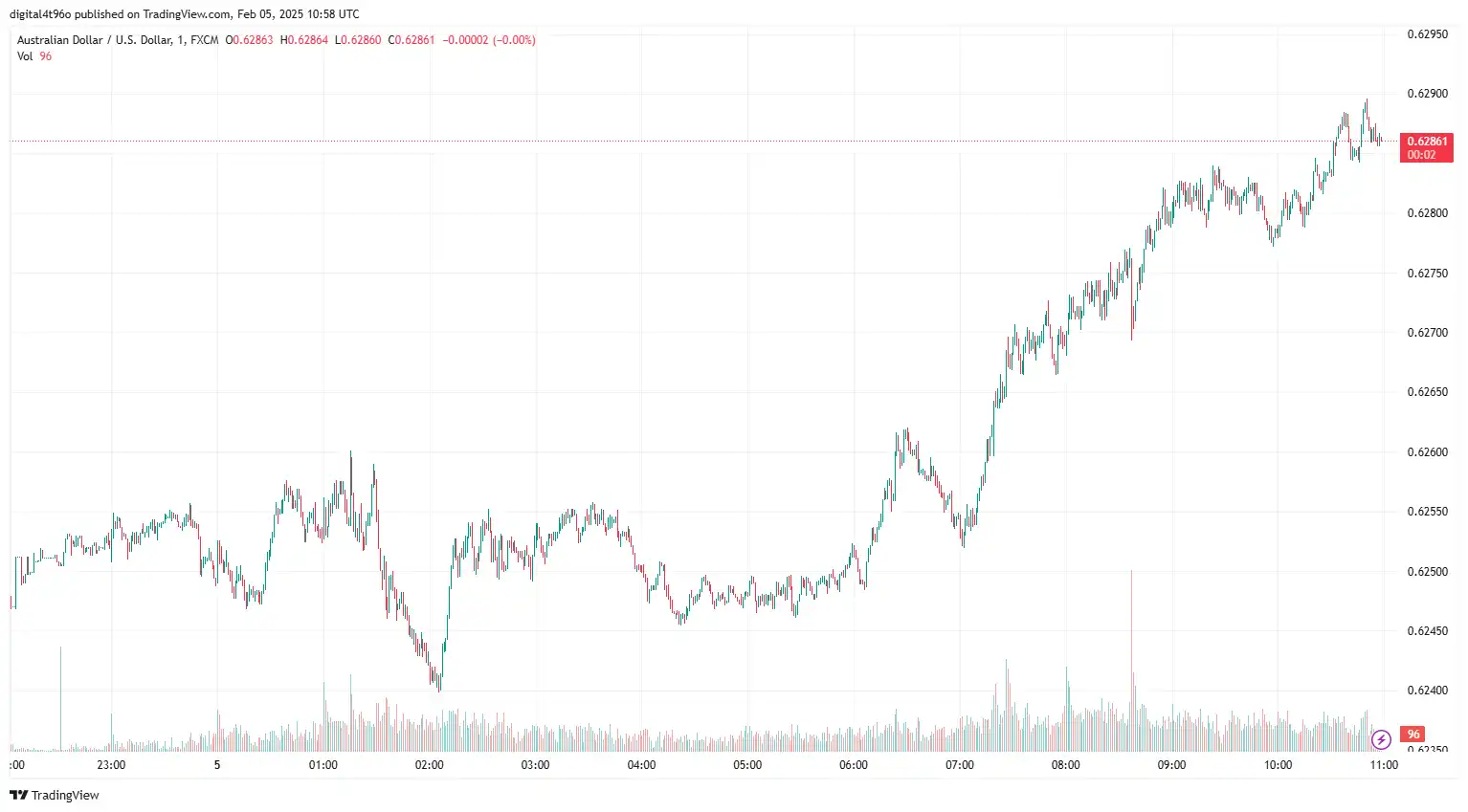The Pound underperforms against the Greenback, trading below 1.2500, due to investors' cautious stance ahead of the Bank of England's (BoE) interest rate decision on Thursday. The market anticipates an interest rate cut of 25 bps, influenced by the recent downbeat UK economic data. Recent UK core CPI figures, excluding volatile items like energy and food, slowed to 3.2% in December. Furthermore, the latest labour market statistics revealed that the economy created 35K new jobs, as business owners postponed hiring due to dissatisfaction with Chancellor of the Exchequer Rachel Reeves's announcement regarding increased employer contributions to National Insurance (NI).
On the other hand, the US dollar faces additional headwinds due to the market reaction to Trump's tariffs. Global risk sentiment remains uplifted by the optimism arising from US President Donald Trump's decision to delay tariffs on Canadian and Mexican imports, easing concerns about a trade war and its probable impacts on the global economy. Recent labour market numbers stirred speculation regarding further policy easing by the Federal Reserve (Fed), adding selling pressure on the currency.
On the economic front, December's US JOLTS Job Openings dropped significantly to 7.6 million, falling short of the 8 million forecasts and down from 8.098 million in November. Additionally, Factory Orders for December decreased by 0.9%, worse than the anticipated decline of 0.7% and a larger decline than the previous month's decrease of 0.4%.
Apart from geopolitical headlines, two influential speakers from the Federal Reserve, Atlanta Fed President Raphael Bostic and San Francisco Fed President Mary Daly, along with Final Services PMI numbers from both regions and ADP Nonfarm Employment Change numbers, will drive the GBP/USD exchange rate.

NZD/USD Buoyed Despite Downbeat Chinese Data
NZD/USD recovered near 0.5685, following domestic labour market data and the Caixin Services Purchasing Managers' Index (PMI) from China, a close trading partner to New Zealand. China's Services PMI unexpectedly declined to 51.0 in January from 52.2 in December, falling short of the estimated figure of 52.3. In Q4 2024, New Zealand's Unemployment Rate rose to 5.1%, up from 4.8% in the previous quarter, aligning with market expectations and marking its highest point since September 2020. Meanwhile, the Employment Rate decreased to 67.4% from 67.7%, and the underutilisation rate saw a slight rise to 12.1% from 11.6% in the prior quarter. Moreover, market anticipations of a 50 bps cut to 3.75% by the Reserve Bank of New Zealand (RBNZ) in an upcoming policy meeting might exert additional pressure on the New Zealand Dollar (NZD).
However, escalating US-China trade tensions have triggered risk-off sentiment, putting pressure on the China-proxy Kiwi. In response to Tuesday's new 10% US tariff, China has implemented its own tariffs, including a 15% levy on US coal and liquefied natural gas (LNG) imports and an additional 10% on crude oil, agricultural equipment, and certain automobiles. Furthermore, China's Commerce Ministry has announced new export regulations, which control tungsten, tellurium, ruthenium, molybdenum, and related products to "safeguard national security interests."
Tuesday's Job Openings and Labour Turnover Survey (JOLTS) figures have shown a slowdown in the US labour market, bolstering market sentiment regarding further policy easing by the Federal Reserve (Fed) as expectations grow that the US central bank will reduce borrowing costs twice this year. December's Factory Orders fell by 0.9%, worse than the expected 0.7% decline and the previous month's 0.4% drop. Meanwhile, December JOLTS Job Openings dropped to 7.6 million, below the expected 8 million and down from 8.1 million in November.
Friday's US Nonfarm Payrolls (NFP) data and influential FOMC member addresses will shape the Federal Reserve's (Fed) monetary policy direction and the NZD/USD exchange rate.

EUR/JPY Sinks Amid BoJ Rate Hike Bets.
EUR/JPY depreciates near 159.05 as the Japanese Yen (JPY) gains from growing wages in Japan and rising anticipations that the Bank of Japan (BoJ) will further hike interest rates. Japan's Labor Cash Earnings rose 4.8% year over year in December, surpassing November's 3.9% and the 3.8% forecast, marking the highest wage growth in nearly 30 years. Real wages, adjusted for inflation, increased by 0.6% in December, marking the second straight month of growth. In January 2025, the Jibun Bank Composite Purchasing Managers' Index (PMI) rose to 51.1, up from December's 50.5, indicating three consecutive months of growth in private sector activity. Additionally, the Services PMI was adjusted upward to 53.0 from the prior reading of 50.9., compared to a preliminary estimate of 52.7. Ongoing US-China trade tensions could increase the safe-haven flows, supporting the yen.
On the other hand, potential trade conflicts and the risk of an economic slowdown continue to pressure the euro. According to today's economic reports, French Industrial Production was 0.4%, declining from November's +0.2%. Spanish Services PMI dropped from 57.3 in December to 54.9 in January, below the estimated 56.7, signalling a slower expansion rate. France Services PMI Business Activity Index printed well below the expected 49.3 in December and 48.2 in January. Italy Services PMI ticked down from 50.7 in December to 50.4 in January. Germany Services PMI climbed to 52.5, up from 51.2 in December, marking a 6-month high, while Germany Composite PMI Output rose to 50.5 from the previous 48.0, reaching an 8-month high. Eurozone Composite PMI rose from 49.6 in December to 50.2, while the Eurozone Services PMI printed at 51.3, slightly below the prior figure of 51.4. On the geopolitical front, in response to Trump's remark, "It will happen with the European Union. I can tell you that because they've really taken advantage of us," French President Emmanuel Macron warned, "If our commercial interests are attacked, Europe, as a true power, will have to make itself respected and therefore react," threatening retaliation.
In today's session, the broader market reaction to the US-imposed tariffs and recent economic releases from both regions will drive the EUR/JPY movements.

AUD/USD Strengthened Amid US-China Tariff Situation
The Australian Dollar struggles against the US dollar, trading near 0.6281, due to intensifying risk-off sentiment following escalating US-China trade conflicts. Australia's Judo Bank Composite PMI rose to 51.1 in January from 50.2 in December, suggesting continued but modest growth in private sector activity. Services PMI increased to 51.2 from 50.8, signalling the twelfth consecutive month of expansion in the services sector.
Australia's Retail Sales saw a slight dip of 0.1% month-on-month in December 2024, marking the first decline in nine months, though the drop was less than the expected 0.7%. On an annual basis, sales grew by 4.6% compared to December 2023, and seasonally adjusted figures revealed a 1.0% rise quarter-on-quarter in Q4 2024. CPI data for December is expected to show subdued inflation, with a forecast of around 2.5% year-on-year, down from the previous 2.8%. The weaker retail sales and inflation figures have stimulated speculation that the Reserve Bank of Australia (RBA) may cut rates by 25 basis points in February.
China's Caixin Manufacturing PMI fell to 50.1 in January, down from 50.5 in December, missing market expectations of stability. Additionally, China's decision to impose a 15% tariff on US coal and LNG imports and an additional 10% on crude oil, farm equipment, and certain automobiles and to implement export controls on tungsten, tellurium, ruthenium, molybdenum, and related products to safeguard national security, could support the Aussie.
The recent US economic docket—including JOLTS Job Openings and ISM PMI numbers—reinforced expectations for further policy easing by the Federal Reserve (Fed). December's Factory Orders fell by 0.9%, worse than the expected 0.7% drop and the previous month's 0.4% decline. Meanwhile, JOLTS data revealed a decrease in job openings to 7.6 million, below the forecasted 8 million and down from 8.1 million in November. The ISM Manufacturing PMI increased to 50.9 in January from 49.3, exceeding expectations of 49.8. The Prices Paid Index climbed to 54.9, the Employment Index rose to 50.3, and the New Orders Index improved to 55.1.
In the upcoming sessions, the AUD/USD's movements will be influenced by concerns over China's economic slowdown, escalating US-China trade tensions, and the potential for RBA policy easing.

Stay Ahead in the Currency Game
Whether you're a daily FX trader or handle international transactions regularly, our 'Currency Pulse' newsletter delivers the news you need to make more informed decisions. Receive concise updates and in-depth insights directly in your LinkedIn feed.
Subscribe to 'Currency Pulse' now and never miss a beat in the currency markets!
Ready to act on today’s insights? Get a free quote or give us a call on: +44 (0)20 7740 0000 to connect with a dedicated portfolio manager for tailored support.
Important: This blog is for informational purposes only and should not be considered financial advice. Currency Solutions does not consider individual investment goals, financial circumstances, or specific requirements of readers. We do not endorse or recommend any particular financial strategies or products discussed. Currency Solutions provides this content as is, without any guarantees of completeness, accuracy, or timeliness.
Important Disclaimer: This blog is for informational purposes only and should not be considered financial advice. Currency Solutions does not take into account the investment objectives, financial situation, or specific needs of any individual readers. We do not endorse or recommend any specific financial strategies, products, or services mentioned in this content. All information is provided “as is” without any representations or warranties, express or implied, regarding its accuracy, completeness, or timeliness.




